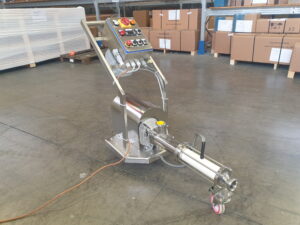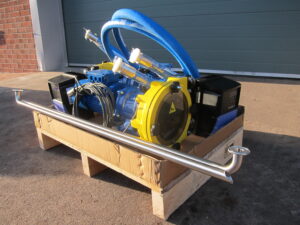 Selecting a pump once you have the process application data can be a difficult choice.
Selecting a pump once you have the process application data can be a difficult choice.
Whether you’re looking to avoid clogging, separation, downtime, or other issue – it’s costly. Time wasted troubleshooting and lower production mean missed targets and less profit.
A sanitary pump is the solution but choosing the right one feels like stepping into a minefield.
You know what you need it to do but with so many options, it’s difficult to know which is best for your process and parameters.
Here are 7 considerations for your process when selecting a pump:
Fixed Pump only or Multipurpose Pump Kit
Fixed pumps assume only one application or process. It can be a great solution if one process or batch is operating repetitively, but what if a process or batch frequently changes? Or what if there are series of infrequent applications across site?
We have found that users are more commonly opting for multipurpose pump kits which can be ported between processes to reduce manual handling, reduce risk of injury or product loss, automate transfer, eliminate spillage and free staff for other processes.
Built to order, units are configured for portability, consistent repeat batching and with controls allowing easy of use with minimal training.
 Reversible Two Applications in one – For Decanting & FIlling
Reversible Two Applications in one – For Decanting & FIlling
Reversible designs enable pumps to be used for more than one process. Whether it be the filling or emptying of containers if known at the outset units can be accommodated to handle two process needs which work at the push of a button.
Cleanability –Manual SIP, CIP, for Reduced downtime during batch changes
Pumps can cleaned in a variety of ways not just for preservation of hygiene, but also to safeguard against cross contamination between food products, and the mixing of colouring’s or flavorings between light and dark prepared mixtures such as creams, or sauces.
Pump designs can vary from having to be cleaned manually which can be ok for small designs used infrequently, but with larger designs this can be laborious and time consuming.
Processes which operate 24/7 or in facilities where frequent downtime is not an option may automate cleaning, using cleaning In Place (CIP) or Sterlisation in Place (SIP) technologies to effectively and efficiently clean pumps in the least amount of time.
Seal Less or Mechanical Seal for Process Security
 Seal less and valveless units mean fewer pump issues and ensure your process continues to run smoothly with less pinch points for product to become trapped, clog or hygiene risks to present.
Seal less and valveless units mean fewer pump issues and ensure your process continues to run smoothly with less pinch points for product to become trapped, clog or hygiene risks to present.
Using seal less designs means the chance of Leakage is vastly reduced, as well as vastly reducing maintenance time.
Working with the correct process partner not tied to a single process technology, can help you understand the advantages and disadvantages of differing designs, helping you to make the right choice for your application.
Shear and Solid Conveyance for ensuring consistency
Transferring solids and viscous liquids requires careful selection. Some solids need to be transferred gently, such as cooked apple slices without breakage.
Other applications may benefit from the damage pumps can perform to solids assisting their processing such as in fruit and berry transfer in juice processing. Milk, sauces, chocolate and eggs require gentle handling to ensure their consistency does not change.
Level of Hygienic Design & Accreditation for Reduced Risk & Insurance Premiums
Pumps are completely configurable from the material of internal components, level of polishing or third party accreditation of components such as FDA or 3A Approval.
If the unit is located within a hazardous environment or handling a flammable ingredient an ATEX and food grade unit may be required.
Knowing which certification is required at the outset, can ensure the most appropriate design of pump is selected reducing risk and also reduce insurance premiums.
Connection Type to Match Your Process
A range of hygienic connections are available to suit your process, from Ticlamp which is most commonly used to RJT, SMS and others.
Selecting this correctly will ensure pumps integrate seamlessly with your pipework and can be cleaned effectively during CIP or SIP for maximum process efficiency.
If you are looking to reduce wastage, maintenance time, risk, and improve output, process effectiveness and ensure consistency speak to us on 01773 302 660, on livechat at www.northridgepumps.com or email at sales@northridgepumps.com .
As we are not tied to a single pump technology we can provide impartial advice on almost any pump design, ensuring your process operates at maximum efficiency.

